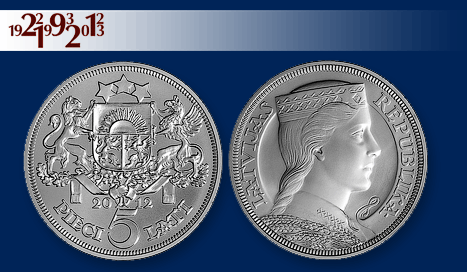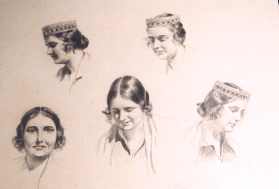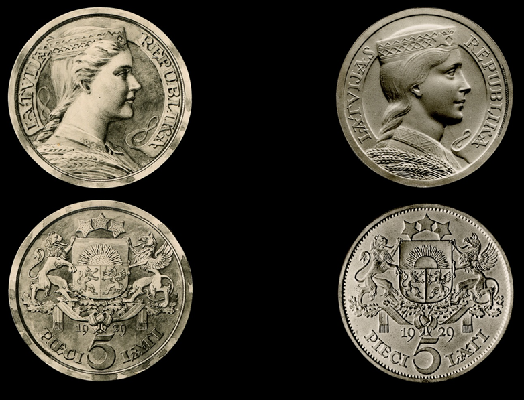 Address by academician Jānis Stradiņš, member of the Coin Design Committee of the Bank of Latvia at the 90th anniversary of the Bank of Latvia and the introduction of the national currency
Address by academician Jānis Stradiņš, member of the Coin Design Committee of the Bank of Latvia at the 90th anniversary of the Bank of Latvia and the introduction of the national currency
1 November 2012
Symbols are very important for the uninterrupted existence of a state and nation; they are not just formal signs of distinction. Symbols unite the nation, they make us think about the point of existence, the paths of history, the destiny of the nation, and they give rise to traditions. Many such Latvian symbols were born during the so-called national awakening [during the second half of the 19th centuty], for instance, the red-white-red flag and our anthem “God, Save Latvia”, but others at the dawn of our statehood. Among the latter, is the state coat of arms, the institution of presidency, the Freedom Monument, the sculpture of Mother Latvia at the Fraternal Cemetery and other symbols, including the lats, which, as a symbol, is less associated with banknotes and smaller denomination coins and much more vividly with the pre-war five-lats coin: the noble maiden with a traditional headdress and ears of corn. This is associated with the image of Latvia; it is our shared relic.
This year, we mark the 90th anniversary of the lats and the lats coins as well as the 90th anniversary of the Bank of Latvia. Let me congratulate all those present but, above all, the Bank of Latvia, its employees and all of us with this important anniversary for our nation.

As early as the summer of 1919, the Provisional government led by Kārlis Ulmanis developed a draft law that provided for the lats as the basic currency unit, yet the National Council postponed adopting it and the idea was carried out only several years later. Various kinds of roubles, including ostroubles and ostmarks, Latvian roubles were circulated. On 14 June 1921, the Constitutional Assembly considered a draft law on a gold franc and the issue of what to call the Latvian currency was not decided. The Ministry of Finance and the Finance and Budget Commission tended toward calling the basic monetary unit a franc and its one-hundredth a centime. The possibilities of "ozols" (oak) and "zīle" (acorn), "saule" (sun) and "austra" (dawn), "līga" and "daile" (beauty), "dižā" (great) and "sīkā" (tiny), latva were also considered. The term "lats" was criticized because it was supposedly associated with the word for a wooden lath – "lata", and at that time (just as now!) there was much speculation with wood. The final decision rested with the Cabinet of Ministers headed by Zigfrīds Meierovics. On 3 August 1922 it decided on lats and santīms (dismissing ‘franc’); but the term "lats" was adopted already a little earlier, on 3 January. Both lats banknotes for larger denominations and silver lats and santims coins were circulated. All the circulated coins had the coat of arms of Latvia and the year they were minted on the back. The designer of the first 2-lats coin was the well-known artist Roberts Tillbergs. He designed also the first 5-lats coin with a rather robust portrait of the newly elected president Jānis Čakste, but it was not struck because of the shared realization that the 5-lats function can also be served by banknotes.
Only in February 1929, the Ministry of Finance resolved that there should be a “head of a maiden” symbolizing the Republic of Latvia and freedom on the silver five-lats coin to be struck at the London Royal Mint. Kārlis Zemdega (Baumanis) won the contest announced by the Academy of Arts, but his sketch was not realized because the maiden should not only be “well drawn technically but also represent a distinctive Latvian character.”
This requirement was met by the prominent Latvian artist Rihards Zariņš (Zarriņš, 1869-1939), who had made a very successful career in St Petersburg working on the design on tsarist Russia’s banknotes (the ‘petrushkas’ and the ‘katenkas’, 1913) and the first Russian postage stamps after the February Revolution. In 1919, Zariņš returned to Latvia, becoming one of the designers of the coat of arms of the Republic of Latvia (after a sketch by Vilis Krūmiņš), and the author of many Latvian paper banknotes. He was a man of conservative views and an artist who, along with J.R. Tillbergs published the satire magazine "Svari", and at the same time – and this is more important in terms of our subject at hand – was the manager of the Securities Printing House on Pushkin Street in Riga, which fact may have been decisive in choosing the author of the coin.
 For the image of Latvian maiden and his model, Zariņš chose Zelma Brauere (1900-1977), a proof-reader of the printing house. At that time, she was 29, a university graduate in philology, young, beautiful, diligent, intelligent and very honest. Zariņš, more than 30 years her senior, was of a high opinion of his employee and chose her as a model for very many of his graphic works (also in "Svari"). He had feelings for the young woman as evident from some letters and dedications, but their relationship seems to have remained platonic. Brauere’s portrait was on two of the banknotes designed by Zariņš and she was a traditional costume model in “Latvju Raksti” (Latvian Ornamets) published by Zariņš and Ludolfs Liberts. Zelma worked at the printing house for 43 years; she knew seven languages and was a careful and responsible worker under different political regimes. After retiring, she lived in a Riga suburb - Āgenskalns (her communion took place at St Martin’s Church) together with her sister, remaining single. She was generous in presenting the five-lats silver coins to her loved ones but hated that the coin was popularly known as a "Milda”: if that happened, she would go quiet in conversation or left the table. She liked to attend various events at the Teachers’ House (now the Swedish Embassy), in front of which she was one evening run over by a motorcycle. Zelma was 77 at the time. The authorities refused to allow her to be buried at the Forest Cemetery, so the final resting place of this “gold standard of Latvian maidenhood” is the Lāčupe Cemetery. Zelma was buried in her traditional costume as seen on the coin.
For the image of Latvian maiden and his model, Zariņš chose Zelma Brauere (1900-1977), a proof-reader of the printing house. At that time, she was 29, a university graduate in philology, young, beautiful, diligent, intelligent and very honest. Zariņš, more than 30 years her senior, was of a high opinion of his employee and chose her as a model for very many of his graphic works (also in "Svari"). He had feelings for the young woman as evident from some letters and dedications, but their relationship seems to have remained platonic. Brauere’s portrait was on two of the banknotes designed by Zariņš and she was a traditional costume model in “Latvju Raksti” (Latvian Ornamets) published by Zariņš and Ludolfs Liberts. Zelma worked at the printing house for 43 years; she knew seven languages and was a careful and responsible worker under different political regimes. After retiring, she lived in a Riga suburb - Āgenskalns (her communion took place at St Martin’s Church) together with her sister, remaining single. She was generous in presenting the five-lats silver coins to her loved ones but hated that the coin was popularly known as a "Milda”: if that happened, she would go quiet in conversation or left the table. She liked to attend various events at the Teachers’ House (now the Swedish Embassy), in front of which she was one evening run over by a motorcycle. Zelma was 77 at the time. The authorities refused to allow her to be buried at the Forest Cemetery, so the final resting place of this “gold standard of Latvian maidenhood” is the Lāčupe Cemetery. Zelma was buried in her traditional costume as seen on the coin.
Today, owing to the kind regard of British Royal Mint, we not only see the plaster forms used many years ago to strike the five-lats coin but also – and this is a first in contemporary Latvia! – Zariņš’s original drawing. It is a realistic portrait of Zelma Brauere with a slight touch of something Schlager-like, but the British engraver Percy Metcalf has made the image more noble, more expressive, a symbol of freedom and lofty ethics. Thus the five-lats piece is the result of joint work by Latvian and British artists. The weight of the coin struck in London was 25,0 g, instead of the standard 31,1 g (the Troy ounce); its diameter was 37,0 mm, but the amount of silver in it was 83,5%, which is lower than the standards set by LBMA (London Bullion Market Association) , i.e., 99,9% and more.

Left: Rihards Zariņš’s drawing of the five-lats coin (the image has been reduced to the size of the coin: April 1929).
Right: Photograph of the plaster models of the five-lats coin by the engraver of the British Royal Mint, Percy Metcalfe (the image has been reduced to the size of the coin; April 1929)
Materials from the presentation by The Royal Mint Museum
5-lats coins were brought from London to Riga and put in circulation on 23 December 1929. They enjoyed immediate popularity: long lines formed by the Bank. The obverse featured the coat of arms of Latvia designed by Zariņš and the reverse a maiden with ears of corn thrown over her shoulder, a thick braid of hair and a crown and collar common for the traditional costume. It was meant to present a symbol of Latvia as an agrarian country with high ethical principles
Let us not forget that 1929 was the year of the great economic crisis and devaluation of values. It was the year of critical novels by Pāvils Rozītis ("Ceplis") and Lūcija Zamaiča ("Direktors Kazrags") and scandal sheets were born. The people desired something noble and beautiful. The Latvian people, the Latvian peasant class is sentimental and responsive to national romantic ideas: the new five-lats piece was an embodiment of its ideal of beauty.
The coin was nicknamed "Milda" and became as popular as the sculpture at the top of the Freedom Monument. Of the first circulation coins, only a few found their way back to the bank: most got stuck in family piggy banks and stockings; they were being given to children and saved.
For a number of the first-issue coins, the word Dievs (God) of the phrase “Dievs, svētī Latviju” (God Save Latvia) was placed directly above the head of the maiden: these were considered particularly lucky coins which were sought after and saved.
Milda remained a symbol when in November 1940 the Soviets began to abolish the lats as legal tender and, on 25 March 1941 at 1 p.m., without any prior warning, all lats, including the five-lats pieces, were taken out of circulation. A big part of the amount remaining in the country (around 3.6 million five-lats pieces) was taken to Moscow. Rumour has it that in the 1960s Vneshtorgbank of the USSR traded in Latvian silver lats, offering them for a rather high (DM 28) to foreign collectors. As of 1941, the lats became a collector’s item.
So even though in the 1950s, in occupied Latvia, the beautiful five-lats coins were no longer legal tender, but they continued the life of a symbol – perhaps even gaining in significance. The coins saved through German and Soviet occupations, were used to make broaches and pendants, they became a coveted present at weddings and christenings. They were kept as a treasured heirloom by people in Latvia as well as those deported to Siberia and in exile abroad. The silver five-lats piece fulfilled a mission very rare for a coin: for those “in the know” it was a symbol of freedom and statehood of Latvia, as a broach it signified one’s belonging to the Latvian nation and hope for regained independence. During the long years of occupation, the coin was also the most popular symbol of once independent Latvia. I remember how in 1972, on an academic trip to Florence, I saw the five-lats piece in an underground coin shop not far from the Uffizzi Gallery – albeit with an inscription that read Lituania. I felt moved and happy that it should exist at a time when Latvia’s name was practically forgotten in the West. Even today it may still be the most popular of Latvian coins: for instance, on the map illustrating the history of money at the National History Museum of Austria in Vienna it is the coin that has been chosen to represent Latvia. Unfortunately, the recognisability of the coin in the world of collectors is limited unlike, for instance the silver coins of the United States and Canada, with their respective symbols of eagle and maple leaf: its value and significance is more of a domestic nature.
As Latvia’s independence was restored, the Bank of Latvia has been minting beautiful silver collector’s lats : these coins are noticed and recognized in the world of numismatics. In Latvia they are recognized as a valuable part of our culture. The set of new Latvian coins, with Zariņš’s 5-lats coin as a predecessor, has been included in the Latvian “cultural canon”. Emotionally and historically this – the only coin struck before the war – is unique, even though in expressiveness and innovation the new coins (by I. Blumbergs, L. Šenbergs, G. Cilītis, J. Strupulis, K. Ģelzis, G. Sietiņš, to name just a few) may top Zariņš’s creation. It is the same as with the anthem – it may not be the most powerful composition musically, but it remains the national anthem. The five-lats piece by Rihards Zariņš is the anthem of our coin world.
It is not a coincidence that the coin presented today is an imitation of Zariņš’s five-lats coin (just with a different year and the higher silver content of 92,5%). It is number ninety in the series of collector’s coins and it is struck to commemorate the 90th anniversary of the Bank of Latvia and the establishment of the lats as our national currency.
To commemorate the five-lats coin, the Bank of Latvia issued its miniature version in gold made by G. Cilītis (within the international coin programme "The World’s Smallest Gold Coins"). Now, to commemorate the 90th anniversary of the Bank of Latvia and the lats, it is Zariņš’s coin that has been struck and this time it is legal tender (though mostly for commemorative purposes).
It is possible that in 2014 we will have to part with the lats and change over to the euro. It is a psychological trauma that has been experienced by other EU countries as well, with France and Germany not excepted. We will no longer have the lats. Perhaps it would be less painful if the name “franc” had been accepted decades earlier. When the public was surveyed as to what symbol they would like to see on the Latvian-issued new one- and two-euro coins, an absolute majority chose the image of Zariņš’s five-lats piece.
That implies that our future money as well (albeit not of silver) would also be somewhat connected to national romanticism and the pre-war five-lats coin, to Rihards Zariņš, Zelma Brauere and out traditions. Independently of where these new euro coins will be struck – probably no longer at London’s Royal Mint – the image of "Milda" will go on living – Latvians just seem to be a patriotic, conservative and sentimental people that does not forget either the happy or the grim periods of their history. It is a people that is capable of preserving its identity – the real or imagined one.
We may be celebrating the last “round” anniversary of the lats. It is hardly likely that it will live to see its centennial – unless the euro dies first, which is not probable. Yet this is no funereal speech: the lats is and will always remain one of Latvia’s treasures. And if, ten years down the road, we will commemorate the centennial since the establishment of the national currency, the commemorative euro coin may once again sport “Milda” by Rihards Zariņš after the likeness of Zelma Brauere.